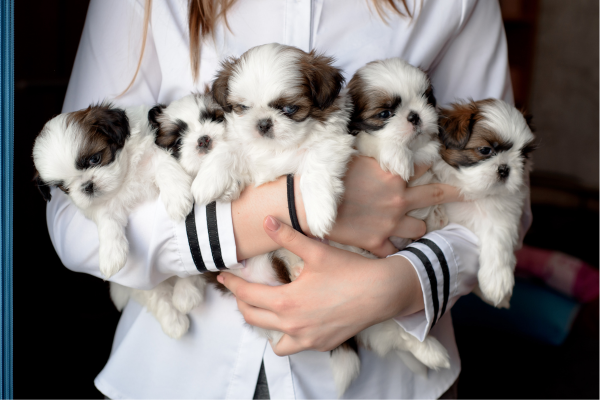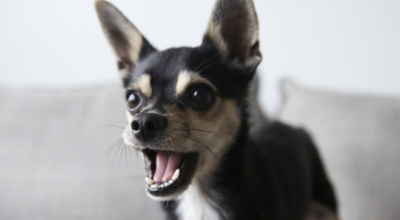Do Chihuahuas have curly tails? Let’s go on a journey to discover the mystery behind Chihuahua tails. We’ll look at the breed’s historical roots, genetic details, and practical concerns that affect its different tail shapes. From the genetics of ancient civilizations to modern dogs, let’s dive into the fascinating world of Chihuahua tails and discover what secrets are hidden in the curl.
Historical Background
The history of the Chihuahua is a captivating journey that transcends centuries, rooted in Mexico’s ancient civilizations. This diminutive breed has left an indelible mark on the canine world, and to understand the unique twists and turns of its tale, we must travel back in time.
✅Ancient Roots in Mexico

The Chihuahua’s lineage can be traced to the ancient civilizations of Mexico, particularly the region of Chihuahua, from which the breed derives its name. Archaeological evidence suggests that small companion dogs resembling Chihuahuas were revered by the indigenous people, such as the Toltec civilization, as far back as the 9th century.
✅Influence of Various Dog Breeds
A Chihuahua’s genes resemble a mosaic, with pieces from many different dog ancestors. Scholars and historians think that the Techichi, a small dog that the ancient Toltecs loved as a pet, was very important in developing the Chihuahua.
In the 16th century, Spanish explorers probably brought European toy breeds into the mix, which changed the Chihuahua’s genetic pool even more.
The unique traits of the Chihuahua breed today come from the mix of different genetic contributions from these other sources. The Chihuahua’s genetic history is like a tapestry of Mexican history. It goes from its ancient roots to the cross-cultural exchange when Europeans came to Mexico.
✅Evolution of Tail Characteristics

To figure out how the Chihuahua’s tail has changed over time, we look at pictures and writings from the past. The appearance of Chihuahuas and the subtle differences between their tails can be seen in artifacts and drawings from different times.
In old Toltec art, small dogs kept as pets are shown with unique tail features. People think that the Techichi is related to the Chihuahua. The Techichi was often depicted with an exquisite tail, though sometimes curly. From these pictures, the Chihuahua’s tail has always been an exciting part of its look.
As the centuries went by, art representations of Chihuahua tails changed, showing how tastes and preferences about them changed. Spanish explorers and settlers may have brought European influences, which may have led to a change in tail shape since different European toy breeds were known for having different tail shapes.
We can learn more about the cultural and aesthetic factors that have changed the Chihuahua’s appearance over time by looking at these historical drawings. The changing ways artists have shown Chihuahuas tell a story about the breed’s history and hint at whether Chihuahuas have always had curly tails or if this trait came about later in their development.
Anatomy of Chihuahua Tails
In the world of Chihuahuas, their unique tails make them stand out. They add even more charm to these already enchanting pets. Let’s take a trip to learn more about the anatomy of Chihuahua tails, breaking down the details of their length, shape, and fur.
✅Typical Appearance
The typical Chihuahua’s tail is a beautiful addition to their small body. It is about average length and tapers gracefully. Different dogs have tails that are the correct length for their size, ranging from 6 to 15 inches. This gives the dogs a balanced look. The high tail makes the Chihuahua look alert and sure of itself.
The fur on the tail is often the same color as the fur on the rest of the body. This gives the animal a smooth, finished look. Chihuahuas with smooth coats have shiny tails, while Chihuahuas with long coats have beautiful plumes that make them look more royal.
✅Tail Variations
One exciting thing about Chihuahua tails is how different they are from one breed to the next. The tail of a typical Chihuahua is either straight or slightly curved, but some dogs have tails that aren’t relatively straight or somewhat curved.
Some Chihuahuas with tails have a subtle curl or twist that makes them look silly. This slight curl, sometimes called a “gay tail,” is cute and does not go against breed standards.
There are also Chihuahuas with corkscrew tails, which are different from the norm because their spiral is more noticeable. Even though they are not very common, these corkscrew tails add to the wide range of tail shapes found in Chihuahuas.
These differences in tails make us wonder what genetic factors are at play and how these differences are passed down within the breed.
✅Genetics and Tail Structure

To figure out why Chihuahua tails are different, we need to look into the complicated world of genetics. The Chihuahua’s tail has features that come from both of its parents.
The genes that control the shape of a Chihuahua’s tail can determine whether it is straight, slightly curled, or shaped like a corkscrew. Breeders carefully choose mating pairs to keep certain traits alive. They do this to keep the breed standard while also enjoying the fun variety that comes with having different tail shapes.
Knowing how genes affect tail structure not only helps us understand the variety of the Chihuahua breed but also makes us realize how important it is to breed dogs responsibly. Chihuahua lovers and breeders need to keep the breed’s integrity. The genetics behind tail traits add an exciting layer to the complex tapestry of this beloved dog.
Genetic Factors
The elegant curve of a Chihuahua’s tail, whether straight, slightly curled, or adorned with a whimsical corkscrew, is not merely a stroke of chance but a result of intricate genetic interplay. In this section, we will delve into the fascinating world of genetic factors, examining how they shape the unique tails of Chihuahuas.
✅Inheritance of Traits
An essential factor that determines the shape of a Chihuahua’s tail is its genes. Every wag, twist, and spiral is written in the dog’s DNA, which it got from both parents. The genetic code has instructions that tell the tail how it should look and what its length, shape, and fur should be like.
These traits are passed down using the ideas of Mendelian genetics, which says that genes from each parent work together to decide the outcome. Breeders who want to make Chihuahuas with consistent and desirable tail traits need to know a lot about the genes of both the sire and the dam.
Multiple genes may affect some traits, but in Chihuahuas, the way tail features are passed down is complicated by a dance between dominant and recessive genes. Breeders carefully look at the pedigrees of possible mates to predict and change the puppies’ tail traits, ensuring they follow breed standards.
✅Breeding Practices and Tail Characteristics
Breeders are significant for shaping the tails of future Chihuahuas by choosing the best times to mate. Breeders need to know a lot about each dog’s genetic traits, especially regarding the tail, to select breeding pairs carefully.
To keep and raise the breed’s standards, responsible breeders choose mating pairs whose tail structures are similar but not the same. Chihuahuas have a unique look that is kept alive by breeding them for consistent tail length, shape, and curliness.
The breed standards that kennel clubs and breed organizations set help breeders choose which dogs to breed. In many ways, including how the tail should look, these standards show what the perfect Chihuahua should be like. Breeding methods that affect tail conformity ensure that Chihuahuas keep showing off the breed’s famous traits and charm.
✅Genetic Mutations and Tail Variations

Genetics adds a level of uncertainty to the world of breeding, where breeders work hard to follow established rules. Genetic changes can happen on their own, which can cause tail shapes that are different from the norm.
Because of these mutations, some dogs, like the corkscrew tail, may get tail patterns that aren’t common in the Chihuahua population. Some mutations may not affect anything, but others add to the breed’s incredible variety.
Learning about the chances of genetic mutations shows how dynamic Chihuahua genetics is. When these mutations aren’t linked to health problems, they can bring about new traits that fans love and make the breeding process more enjoyable.
Practical Considerations
As we marvel at the charming aesthetics of Chihuahua tails, it’s imperative to delve into the practical considerations that underlie these distinctive appendages. From their role in balance to the subtle language of canine communication, Chihuahua tails are not just ornamental – they serve vital functions in the lives of these pint-sized companions.
✅Balance and Communication

Chihuahuas may be small, but their tails help them stay balanced, especially when going over different types of ground. Their high set, gracefully tapering tails help them be agile, allowing them to turn quickly and precisely. People who watch Chihuahuas can see how the tail helps them stay stable by acting as a counterbalance.
The way Chihuahua tails help them talk is just as important. Chihuahuas’ tails are just as good as any other dog’s for showing their feelings and wants. A raised tail can mean that a dog is happy or sure of itself, while a tucked tail can tell that the dog is scared or giving up.
Chihuahuas communicate with people and other dogs by changing how their tails move and position themselves. Other dogs and people also understand this language.
✅Impact of Curliness on Behavior and Well-being
People often wonder how a Chihuahua’s tail curls affect its behavior or general health. There is no direct link between a Chihuahua’s tail curliness and its personality, but some dog lovers think that dogs with slightly curled or corkscrew tails might be more playful or charming.
It’s important to remember that a Chihuahua’s behavior is a mix of genetics, early socialization, and its unique personality. A curled tail may help a dog show more emotions, but it’s not the only thing determining a dog’s personality. No matter what shape its tail is, every Chihuahua has unique traits and habits.
There is no evidence that a Chihuahua’s health is affected by how curly its tail is. No matter what shape its tail is, the dog can live a happy and healthy life if it is not hurt or deformed. Regular check-ups with the vet can ensure that any problems with the tail are taken care of quickly, which is good for the Chihuahua’s overall health.
✅Debunking Myths and Addressing Misconceptions

Because of their cute differences, Chihuahua tails have sometimes been the subject of myths and false beliefs. A common misunderstanding is that a dog’s tightly curled tail means it is in pain or discomfort. In reality, many Chihuahuas with naturally curly tails don’t show any signs of being upset and live happy lives.
In another myth, the curly tail of a Chihuahua is thought to be caused by too much breeding or inbreeding. Responsible breeding practices try to keep breed standards, but the different tail shapes in the Chihuahua population are caused by the complicated way genes interact.
By busting these myths and clearing up these misunderstandings, we can help people learn more about Chihuahua tails and enjoy the breed’s variety without worrying or making assumptions that aren’t necessary.
Expert Opinions
To gain a deeper understanding of the intricate world of Chihuahua tails, we turn to the invaluable insights offered by experts in the field. Veterinarians, breeders, and canine geneticists bring their wealth of knowledge and experience to shed light on the nuances of Chihuahua tail characteristics.
✅Insights from Veterinarians

As guardians of animal health, veterinarians play a pivotal role in assessing and addressing any potential concerns related to Chihuahua tails. According to Dr. Emily Thompson, a seasoned veterinarian focusing on small breeds, “Chihuahua tails, regardless of shape, are generally healthy. Pet owners must observe their Chihuahua’s tail for signs of discomfort, such as changes in movement or sensitivity during touch. Regular veterinary check-ups ensure that any issues related to the tail are promptly addressed, contributing to the dog’s overall well-being.”
✅Perspectives from Breeders

Breeders, who are intimately familiar with the intricacies of Chihuahua genetics, provide valuable insights into the intentional breeding practices that influence tail characteristics. Maria Rodriguez, a reputable Chihuahua breeder with decades of experience, emphasizes the role of responsible breeding. “Tail characteristics are an integral part of breed standards, and responsible breeders strive to produce Chihuahuas that adhere to these standards. While variations in tail shapes exist, it’s essential to prioritize the health and temperament of the dog in the breeding process. Regardless of tail shape, a well-bred Chihuahua should embody the breed’s essence.”
✅Canine Geneticists’ Perspective

Canine geneticists contribute a scientific lens to the discussion, unraveling the mysteries encoded in a Chihuahua’s DNA. Dr. Jonathan Carter, a leading researcher in canine genetics, explains, “The genetics of Chihuahua tails involve a complex interplay of multiple genes. Tail variations, from straight to slightly curled or corkscrew, result from genetic diversity within the breed. While responsible breeding practices aim to maintain consistency, genetic mutations can contribute to the delightful diversity seen in Chihuahua tails. Understanding these genetic factors enhances our appreciation for the natural variations within the breed.”
✅Assessing Health and Quality through Tails
Are Chihuahua tail characteristics indicative of overall health and quality? Perspectives among experts vary, but there is a consensus that while tail characteristics contribute to the breed’s aesthetic appeal, they are not standalone indicators of a Chihuahua’s health or quality.
Dr. Susan Miller, a respected veterinarian specializing in small breeds, notes, “Tail characteristics should be considered within the broader context of a Chihuahua’s health and temperament. While breed standards guide responsible breeding practices, it’s crucial to prioritize overall well-being. A Chihuahua with a slightly curled or corkscrew tail can be as healthy and vibrant as one with a straight tail; provided there are no underlying health issues.”
In conclusion, the insights from veterinarians, breeders, and canine geneticists emphasize the multifaceted nature of Chihuahua tails. Responsible breeding, regular veterinary care, and a holistic approach to assessing a Chihuahua’s health collectively contribute to the well-being of these endearing companions.
FAQ’s
Do all Chihuahuas have curly tails?
- No, not all Chihuahuas have curly tails. The breed standard allows for variations, and Chihuahua tails can be straight, slightly curled, or even corkscrew-shaped.
Are straight-tailed Chihuahuas less familiar or less desirable?
- Straight-tailed Chihuahuas are more common and desirable. Tail variations are part of the breed’s charm, and responsible breeders prioritize overall health and temperament over specific tail shapes.
What role do Chihuahua tails play in their behavior?
- Chihuahua tails play a crucial role in communication. The position and movement of the tail can express a range of emotions, from excitement and confidence to fear or submission.
Can the curliness of a Chihuahua’s tail impact its health?
- Generally, the curliness of a Chihuahua’s tail does not directly impact its health. However, a veterinarian should promptly address any signs of discomfort or abnormalities.
Do breeders intentionally breed for specific tail shapes in Chihuahuas?
- Responsible breeders aim to adhere to breed standards, which may include preferences for specific tail characteristics. However, the primary focus is breeding healthy, well-tempered Chihuahuas embodying the breed’s essence.
Are Chihuahuas with corkscrew tails more prone to health issues?
- No evidence suggests that Chihuahuas with corkscrew tails are more prone to health issues. Chihuahuas with various tail shapes can lead healthy lives as long as the tail does not cause discomfort or pose health risks.
Can tail characteristics be an indicator of a Chihuahua’s overall quality?
- While tail characteristics contribute to the breed’s aesthetic appeal, they are not standalone indicators of a Chihuahua’s overall quality. Health, temperament, and adherence to breed standards collectively determine the dog’s quality.
Should I be concerned about my Chihuahua’s tail being perfectly straight or curled?
- Not necessarily. Chihuahuas exhibit natural tail variations. If your dog’s tail is not causing discomfort and they show good health and behavior, there is generally no cause for concern.
Can Chihuahua tails be straightened or curled through grooming or manipulation?
- No, attempting to straighten or curl a Chihuahua’s tail through grooming or manipulation is not recommended. The natural shape of the tail is determined by genetics, and trying to alter it may cause discomfort or harm to the dog.
Are there specific exercises or activities to keep a Chihuahua’s tail healthy?
- Chihuahuas typically maintain healthy tails through regular activity and a balanced lifestyle. However, routine veterinary check-ups can ensure that any potential tail-related issues are addressed promptly.
Remember that individual Chihuahuas may vary, and it’s always advisable to consult with a veterinarian for personalized guidance on the health and well-being of your furry companion.
Final Words
Chihuahua tails are like paintings that show how unique and charming the breed is. The history, genetics, and care of breeders have shaped Chihuahua tails from ancient Mexico to modern breeding.
We learned more about Chihuahua tails, including their anatomy, genetics, practical issues, and expert opinions, and realized that these small parts play many essential roles in these beloved pets. Chihuahua tails are more than pretty. They aid in balance, communication, and the dogs’ silent language with people.
Veterinarians, breeders, and canine geneticists shared their ideas, helping us understand how genetics and responsible breeding connect. These experts strengthened our research by emphasizing the importance of complete care and prioritizing health and temperament when breeding Chihuahuas.
Though Chihuahua tails can be straight, slightly curled, or corkscrew, each has its personality and habits. Long and happy lives for these little friends depend on responsible breeding, regular vet visits, and a commitment to their health and happiness.
The mystery of Chihuahua tails remains a draw. Let us appreciate each Chihuahua’s unique tail and remember that their tails, like their dogs, enrich canine companionship. May a Chihuahua’s tail wag bring joy, laughter, and endless charm to homes worldwide.
Here at ILoveChihuahua, we share our personal experiences as owners of this feisty breed. We talk about recommended methods, dog supplies picks, and advice on common Chihuahua problems. Our goal is to promote responsible dog ownership, so there would be fewer Chihuahuas in shelters.


